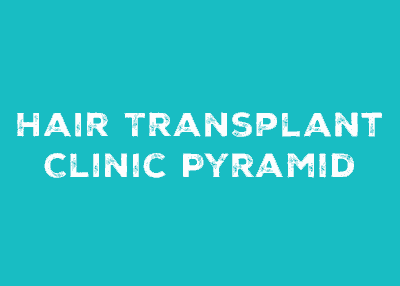Hair Transplant Pyramid of Excellence

Not All Hair Transplant Physicians Are The Same
I just did a google search for “hair transplant” in my state (New York) and pages upon pages of physicians claiming to be hair transplant specialists came up. I went through their websites and I can only imagine how confusing it all must be for a person just beginning their research into hair transplantation. To the beginner all these doctors’ websites must look more or less the same-and with good reason. Look at the similarities among all of them:
- They all claim in one way or another to be “great”, “leaders in the field” and “experienced”.
- They all have a gallery section showing off before/after photos of some of their patients.
- And they all tout impressive medical credentials and association with various medical/surgical organizations.
On paper it would SEEM that all hair restoration surgeons are essentially the same, so selecting a few to investigate further for one’s own transplant should be a no-brainer, right ? Yet intuitively everyone knows they can’t just pick a few doctors at random. Deep deep down everyone knows NOT all the doctors on a google page are the same. But how does one even begin to sort the best hair transplant physicians from the really not so great ones ? That is to say, how do you separate out what looks good on paper from what is good in the real world ?
The answer may well be the Hair Transplant Pyramid of Excellence pictured above.
The Hair Transplant Pyramid of Excellence
I created this pyramid as a quick way to filter out the lower end clinics from the top tier. The criteria listed in each tier correlates almost perfectly with the ACTUAL quality of the clinic being researched. So let’s say you found a physician website online and want to evaluate it. Surf that doctor’s website with a print out of the Pyramid next to your keyboard. Start with the criteria on the lowest tier (red) of the pyramid by making sure that doctor you are researching does not offer or engage in what is listed. Then, as you make your way to the TOP tier, make sure that doctor IS engaging in what is listed there. It’s that simple and quick. If the website doesn’t make it clear then pick up the phone and call the office of that doctor and ask. Again, start from the base of they pyramid and work your way up while you are on the phone with their representative. In another blog we will provide you with a checklist to ask your prospective clinic doctor or representative.
In the end you will find that only about 1% of the doctors you view online will fall into the very TOP tier. These are the only doctors you want to seriously consider for your hair transplant.
Negative Criteria
Here are some aspects of any and all clinics that you want to avoid. They are in the red and yellow parts of the pyramid:
- FUE-Only– Avoid clinics who ONLY offer FUE procedures to the exclusion of Follicular Unit Extraction ( Strip/FUT). FUT is the gold standard in hair transplantation and any clinic that doesn’t offer it cannot call itself a full fledged hair transplant practice. The reason these clinics don’t offer the FUT procedure is simply because they can’t or won’t perform it. Period. In all all cases it is because they are either under trained, under staffed, under funded, inexperienced, and/or don’t have the facility to support the large staff and equipment that FUT procedures require. Instead, these clinics falsely claim or imply (as an excuse) that FUT is an old fashioned procedure that shouldn’t be performed. Of course this is pure nonsense. It is easy and cheap to get into the hair transplant field if one practices only FUE to the exclusion of FUT. The problem is that the results of all FUE surgery are consistently inferior to that produced by an equal size FUT procedure- so by only offering FUE the practitioner is acting unethically. And if the FUE-only physician doesn’t discuss the benefits of FUT surgery, even though they won’t or can’t perform it, they are engaging in the act of failing to give informed consent- which is illegal in New York and other states as well. It is wrong for a physician to deny any patient the best procedure for their hair restoration simply because they can’t offer it- and is specifically why I would exclude FUE-only clinics from any consideration.
- Part Time Practice – Avoid physicians who do not practice hair transplantation full time. The overwhelming number of hair transplant physicians out there, an astounding 99%, fit into this category. The rest of their time is usually dedicated to some other specialty in medicine which they consider to be their true “bread and butter”. For them, hair transplantation is just a “side job” to make a few extra bucks. The obvious problem here is that such physicians cannot compare to the 1% of surgical hair restoration doctors who ACTUALLY specialize in hair transplantation and perform procedures on a daily basis. Surgery is like a musical instrument-the more you practice, the better you get. Inversely, if you don’t use it, you lose it. There are no exceptions to this rule. Seek out full time hair transplant doctors and ignore the part timers. You deserve better AND it’s just common sense.
- Traveling Technicians– This is a term I coined years ago as a negative expression when I started to realize that the worst results I was seeing were coming out of clinics that used per Diem medical assistants as hair transplant technicians. There is nothing wrong with using medical assistants to help perform hair transplant procedures- in fact modern day hair transplants couldn’t be performed without them. However, there is a huge difference between a technician who works everyday performing hair transplants and the type that works for a part time hair transplant doctor who may only do one procedure per week. Many, if not most, of these traveling technicians operate as “independent contractors”-a practice that is illegal in New York and probably in every other state as well. When a doctor illegally hires a traveling tech the technician becomes the person running the case, not the doctor. Doctors who hire traveling techs are usually too inexperienced to be able to evaluate and direct the technician and therefore it de facto becomes the technician, not the doctor, who performs the procedure. Alternatively, just look at it this way: successful clinics that work nearly everyday can afford to hire, train, and employ their own staff on a full time basis. Unsuccessful clinics cannot, and that’s why they use traveling techs. If the clinic you are considering does not have it’s own exclusive in-house staff drop them from consideration and look for the 1% of clinics that do.
- Non-Specialized Physician – As mentioned above in “Part Time Practice” criteria, the non-specialized hair transplant physician should be avoided. All of these doctors specialize in some other area of medicine and don’t give their full attention and effort to hair transplantation. Without exception these doctors are under trained, under staffed, under experienced, most often do not have a team of in-house technicians, and very rarely (if ever) perform the FUT procedure-the gold standard for hair transplantation.
- Fewer than 5 Patients per Month – Clearly a hair transplant clinic that only operates on five patients per month cannot compare in any way to one that performs 5 procedures per week. The best clinics perform a minimum average of 4 cases per week-and these cases are usually of the mega session variety. How can a clinic train and keep a large army of in-house technicians if they only work once per week ? How are the doctor and the staff supposed to finely hone their skill if they only operate as a team a grand total of about 4 times per month ? The answer is simple-they can’t. Look for the 1% of clinics that do.
- Use of so-called Hair Transplant Machines – By far the worst results produced in the hair transplant field on a consistent basis today are by physicians who use so-called automated and semi-automated hair transplant machines. There are a few brand names I will not name here but they are all, universally, terrible from a surgical point of view. Here are a few reasons why:
- Technician Operated– Almost all of these machines are NOT operated by the doctor, but rather an unlicensed and unqualified “technician”. In most cases the doctor is sitting in the other room reading the paper or seeing patients in his “real” practice while the technician performs the surgery. This is unethical and illegal in the state of New York and other states as well but this has not stopped doctors from doing this as law enforcement has bigger fish to fry. To respond to this the ISHRS, THE major hair transplant physician organization, created an awareness campaign to combat this rampant practice.
- Poorer Results– All machine-assisted hair transplant procedures are of the FUE type. All, without exception. No matter how much these devices are hyped and touted as “revolutionary”- NONE of them actually are. And none of them are superior to either a properly performed FUT procedure or a properly performed manual FUE procedure. These machines are just too rough on the tissue and the hair grafts they were “designed” to remove. At their core, all of these machines include: a spinning punch, a tube through which grafts are supposed to be sucked though, and a storage container. The major problems are that the suction dries out the graft, which is deadly, and the hand pieces supporting the spinning punch are so heavy and torqued that the doctor can’t “feel” what’s going on under the skin the way he or she could if only a manual FUE punch were used. Because of this the results are ALWAYS inferior to an equivalent sized FUT procedure or manually performed FUE procedure. The machines, in fact, really only make the performance of the procedure faster and more convenient for the doctor. None of them improve the results for the patient. 99% of clinics using machines to perform hair transplant surgery are part time clinics staffed by non-specialized physicians using traveling techs who perform fewer than 5 procedures per month. This is a horrible combination and represents the lowest tier clinic on the Pyramid.
- Not a single physician who is capable of performing FUT and/or manual FUE has given up performing either since the introduction of ANY of these hair transplant machines. And isn’t it interesting to note that the overwhelming majority of doctors purchasing these machines are those who can’t perform FUT ? Almost by definition: if a clinic uses one of these machines, then they may safely be classified in the lowest tier of the hair transplant Pyramid and should therefore be avoided.
- Common Sense– If these machines really worked, why wouldn’t I and every seasoned hair transplant doctor purchase several of them. We don’t because they are very traumatic to the grafts and unnecessarily injurious to the tissue and surrounding hair.
Unfortunately MOST physicians who have entered the hair transplant field since 2010 are not adequately trained. While they may have some basic knowledge as to how an FUT procedure is performed the overwhelming majority of them do not perform FUT on a regular basis- mostly because they do not have the staff or the facility. As a result they are inexperienced and ill prepared to create the optimal hairline, perform mega sessions, or offer dense packing. To make up for this shortfall all such low tier clinics require multiple visits to make any kind of significant cosmetic difference. In direct contrast, the 1% Top tier physicians provide patients with significant cosmetic improvement after just a single visit.
Positive Criteria
Here are some positive aspects of clinics you want to consider very strongly for your hair transplant:
- Performs BOTH FUT and FUE – The very best clinics in the world perform both procedures on a regular basis. FUT is the gold standard of hair transplantation without which there simply would be no viable hair transplant industry. Doctors who perform FUT are usually well established, have their own in-house staff of hair transplant technicians who have worked as a team for decades, and have a facility modern enough and large enough to accommodate them. Only successful hair transplant physicians can afford all of this, and only the most dedicated can even just create all this. These doctors primarily offer the FUT procedure, but they know when and how to offer the FUE procedure as well. While FUT is the best hair transplant procedure for large sessions (mega sessions), FUE should be limited to small session sizes and repairs of no more than about 1,500 grafts as a life time maximum. Less if possible.
- Full Time Practice – These are the doctors you should be actively seeking out- but it may not be that easy considering they represent only about 1% of the hair transplant doctor population. These are the doctors that made the hair transplant industry into the success it is today; whereas part time FUE-only doctors have been rapidly destroying the reputation and good faith built up by dedicated FUT doctors over the past 25 years. Full time hair transplant doctors are by far the highest trained, the most dedicated, and the most experienced because they perform about 15 procedures or more per month on average. And the average expected growth of an FUT procedure far outweighs that of an equivalent FUE procedure.
- In-House Technicians – This is the polar opposite of the illegal Traveling technicians mentioned above. These technicians were hired and trained in-house and are the exclusive employees of the clinic. ONLY top tier clinics have this kind of staff because only successful clinics can afford to pay them and be able to keep a facility large enough to accommodate them. These techs perform FUT and FUE routinely and in such clinics the doctor fully directs the technician as to how they perform their duties as opposed to the other way around found in FUE-only clinics and Machine clinics.
Other things to look for in a clinic are:
- At least 100 before/after photos. Don’t settle for 5 or 10.
- Of the before/after photos at least 20 must be of patients who had surgery within the past 2 years.
- The doctor should participate in online hair transplant chat forums regularly. This shows that the doctor is very transparent and not averse to having their work viewed, evaluated, and critiqued by anyone and everyone in the world. Only the most successful and confident doctors will submit to this level of scrutiny. Lower tier doctors don’t go near such chat forums.
- Impressive before/after photos
- Honest before/after photo results– not ones where the hair is combed away from the scalp in the before photo and then combed over the scalp and the hair transplant in the after photos.
- When visiting for consultation look for at least 8 workstations for technicians complete with stereoscopic microscopes. If the technicians only use magnifiers you should seriously consider finding another clinic for your hair transplant.
Use the Pyramid to Help Guide Your Search
The pyramid is here to help you guide your search. Use it. That’s what it’s there for. If a clinic you found online has the bad qualities of the lower tier clinics then discard it immediately from consideration. If, however, a clinic whose website you have been surfing has all the good qualities of the highest tier clinics then those are the clinics you should look into. Call the number listed in the website to confirm that they indeed conform to all the positive attributes in the top of the pyramid while also free of the negative attributes listed in the mid and lower tiers. You won’t find a better filter than the pyramid. Then schedule your consultation.
Best of luck with your search.
Links to YouTube Videos:
About the Author:
Dr. Alan Feller is a full time hair transplant physician in Great Neck, NY who has specialized since 1994.
The views expressed in this document are solely the views and opinion of the author. This document is intended for informational purposes only and is not medical/legal advice or a substitute for consultation with a licensed physician in a particular case or circumstance.






